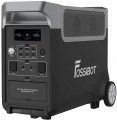Add to comparison |  |  |
|---|---|---|
| Choetech BS009 | Fossibot F3600 | |
| Outdated Product | from £2,037.11 | |
| TOP sellers | ||
Removable flashlight, 5 speeds of charging power. The PRO version model has identical technical characteristics. | ||
| In box | charging station | charging station |
| Rated power | 3600 W | 3600 W |
| Peak power | 7200 W | 7200 W |
| Output waveform | sinusoid (PSW) | sinusoid (PSW) |
| UPS function | ||
Outputs | ||
| Sockets (230 V) | 3 | 3 |
| USB A (quick charge) | 2 18 W | 2 18 W |
| USB C | 4 100 W | 4 5 A 100 W |
| Car cigarette lighter | ||
Inputs (station charging) | ||
| From solar panels | ||
| Input port XT60 | ||
Battery and charging time | ||
| Connecting an additional battery | ||
| Battery type | LiFePO4 | LiFePO4 |
| Battery capacity | 3840 W*h | 3840 W*h |
| Charging cycles | 6500 | |
| Charging time (socket) ≈ | 150 min | 120 min |
| Charging time (socket + solar panel) ≈ | 78 min | 90 min |
| Charging time (solar panel) ≈ | 150 min | 120 min |
| Charging time (cigarette lighter) ≈ | 960 min | |
| Charging power (socket) | 1500 W | 2200 W |
| Charging power (solar panel) | 1500 W | 2000 W |
| Charging power (cigarette lighter) | 120 W | |
| Charging power (socket + solar panel) | 4200 W | |
General | ||
| PSU | built into the body | built into the body |
| Display | ||
| Backlight | ||
| Wheels for transportation | ||
| Carrying handle | ||
| Operating temperature | -10 °C ~ +40 °C | -10 °C ~ +40 °C |
| Dimensions | 464x320x584 mm | 609x321x475 mm |
| Weight | 45 kg | 42 kg |
| Warranty | 2 years | |
| Added to E-Catalog | january 2024 | august 2023 |
Charging stations Choetech BS009 and Fossibot F3600 have similar characteristics but differ in some aspects. Both models offer a nominal power of 3600 W and peak power of 7200 W, and support the UPS function with a switching time of 10 ms. The Choetech BS009 is equipped with a 75 Ah battery and charging time from the grid is about 150 minutes, while the Fossibot F3600 has a slightly larger capacity of 80 Ah and charges faster from the grid, in approximately 120 minutes. In terms of outputs, both stations have 3 sockets at 230 V and 2 USB A ports, but Fossibot offers additional XT90 ports for connecting additional batteries. Users note that the Fossibot F3600 features a more advanced charging system with the ability to connect multiple sources, making it more versatile. The Choetech BS009, on the other hand, stands out for its ease of use and good mobility thanks to its wheels and handle. Overall, the choice between these models depends on your power and functionality needs.